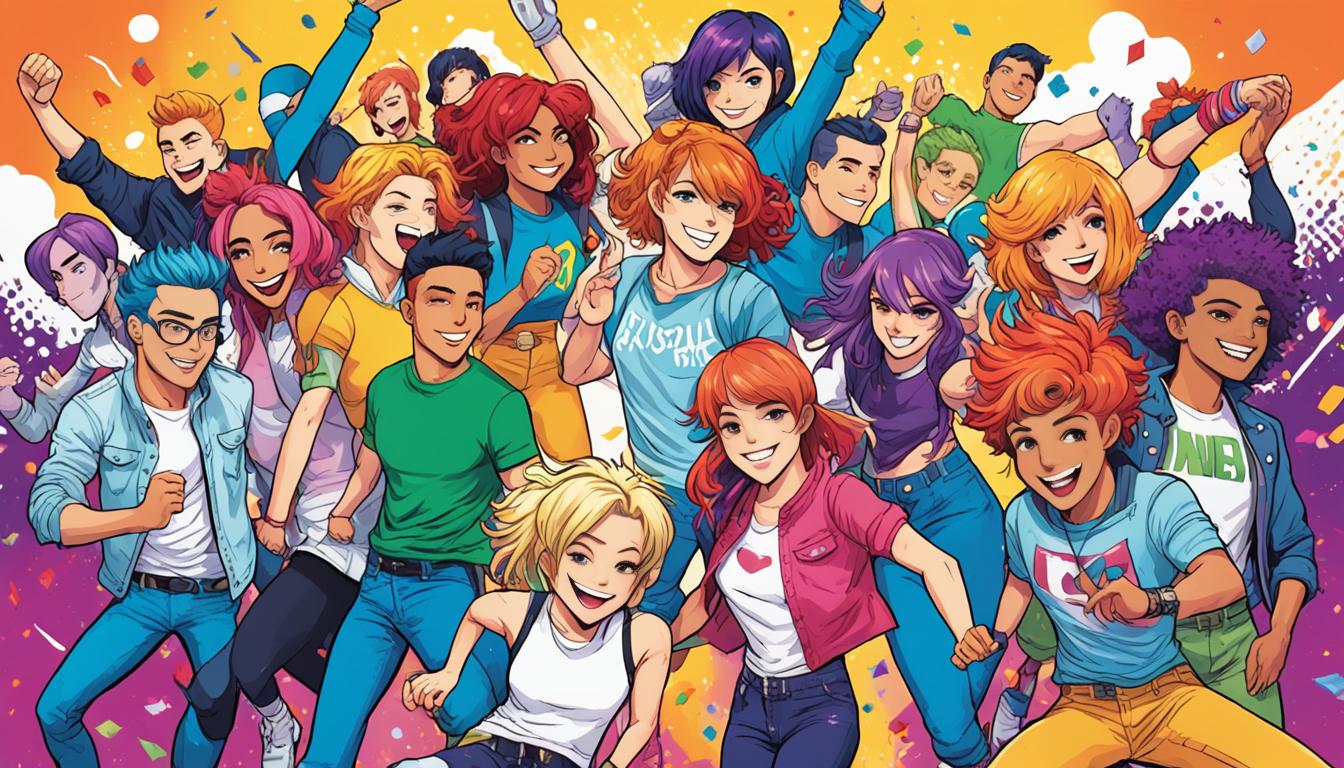As of May 18, 2023, the list includes 21 top anime and manga for the LGBTQ+ community. These stories resonate with many, from slice-of-life tales to those in fantasy and science fiction universes. This piece looks at why LGBTQ+ representation in anime and manga matters. It dives into how these shows and books impact their fans.
Key Takeaways
- There is a growing number of anime and manga series that celebrate LGBTQ+ representation.
- “Revolutionary Girl Utena” is considered a landmark LGBTQ+ anime series.
- Diverse genres, from slice-of-life to fantasy, are showcasing LGBTQ+ characters and themes.
- Manga series like “Given” and “Bloom into You” have had a lasting impact on the LGBTQ+ genre.
- Anime and manga are providing meaningful representation and resonance for the LGBTQ+ community.
The Importance of LGBTQ+ Representation in Media
LGBTQ+ representation is crucial, especially in anime and manga. It gives a voice to diverse stories that connect with the community. These series showcase LGBTQ+ characters and stories. They help promote self-acceptance and understanding.
The importance of LGBTQ+ representation in anime and manga is very high. Many LGBTQ+ people face challenges like depression and isolation. Seeing LGBTQ+ characters in media can be positive. It provides role models and a sense of belonging. This can help with mental health struggles.
The anime and manga industries are making progress. They are telling more LGBTQ+ stories. The GLAAD report shows an increase in LGBTQ+ characters on TV and in films. It also shows a wider range of stories being shared.
| Statistic | Percentage |
|---|---|
| Non-LGBTQ respondents who are more supportive of equal rights for LGBTQ people after being exposed to LGBTQ people in media | 80% |
| Non-LGBTQ respondents who are more supportive of equal rights for LGBTQ people without recent exposure to LGBTQ people in media | 70% |
| LGBTQ characters on cable television who were people of color in 2021 | Over 50% |
| Increase in queer women characters compared to queer men characters in films in 2021 | Significant growth |
Yet, there are still struggles. Not all LGBTQ+ representation is positive. Some are stuck in stereotypes. Making LGBTQ+ representation more meaningful is a key challenge. It’s important to work on better and more diverse stories.
The influence of anime and manga keeps growing. This means the importance of LGBTQ+ representation in anime and manga is also increasing. These stories can change how people view the LGBTQ+ community. They help in accepting others and creating a fairer world.
Anime Series Celebrating LGBTQ+ Characters
Anime fans love shows like Yuri on Ice, Revolutionary Girl Utena, and Wandering Son (Hourou Musuko). These LGBTQ+ anime series tell stories with amazing LGBTQ+ characters. Think of the stunning skaters in Yuri on Ice or the bold heroes in Revolutionary Girl Utena and Wandering Son (Hourou Musuko).
Yuri on Ice
Yuri on Ice dazzles with its tale of figure skaters in high-stakes competitions. We follow Yuri Katsuki’s quest for gold, guided by his coach Victor Nikiforov. The deep bond between these male leads has touched hearts, making this among the top anime highlighting LGBTQ+ characters.
Revolutionary Girl Utena
Revolutionary Girl Utena shakes up conventions by showcasing Utena Tenjou, who dresses in a tomboy style. This challenges what society expects of her. The show explores deep themes around gender, offering a fresh take on LGBTQ+ issues.
Wandering Son (Hourou Musuko)
In Wandering Son (Hourou Musuko), we meet Shuuichi and Yoshino, two students finding themselves. It’s a moving story about understanding and accepting who you are. This anime is a gem for viewers wanting to see realistic transgender stories within LGBTQ+ anime series.
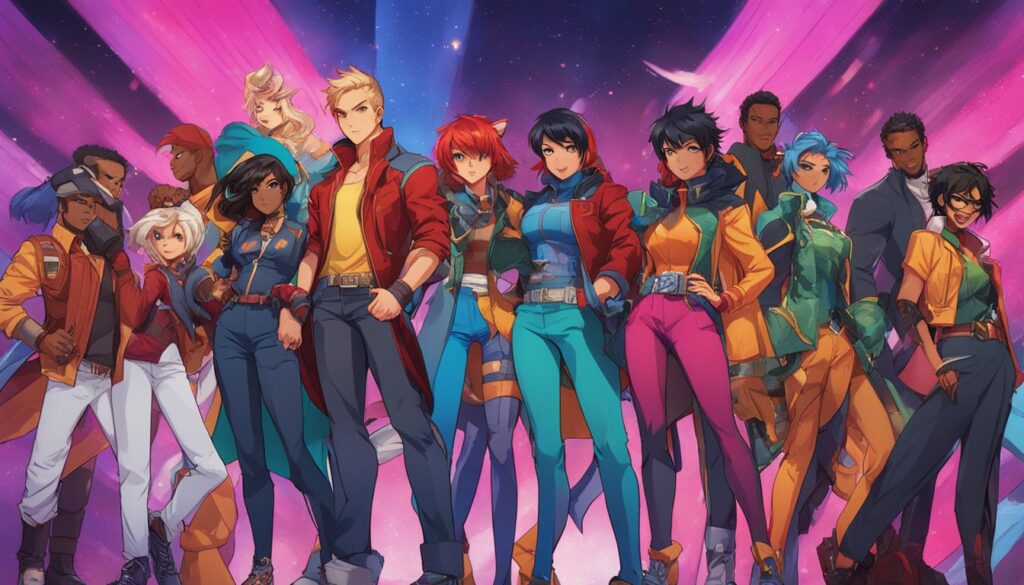
Slice-of-Life Anime With LGBTQ+ Themes
In the world of slice-of-life anime, some standout series include Bloom into You and Sasaki and Miyano. They tell stories about LGBTQ+ relationships in a real and deep way. These shows are loved by many because they touch on love, identity, and finding oneself. They are highly valued in the LGBTQ+ community.
Bloom into You
Bloom into You tells a story about not feeling romantic love, which is quite rare in storytelling. Yuu, the main character, is a high school student who has never felt those butterflies. Then, she meets Touko, the student council president. Touko helps Yuu understand herself better.
This series is praised for how it shows the LGBTQ+ experience. It’s sincere and relatable. The characters’ journey feels real and meaningful, making it a favorite for those who want to see authentic LGBTQ+ stories.
Sasaki and Miyano
Sasaki and Miyano is a recent hit in the boys’ love anime genre. It’s about two boys becoming more than friends. The show explores finding oneself and the issues LGBTQ+ people often face. It feels warm and familiar to many viewers because of its heartfelt approach.
It has quickly become known as a must-watch for anyone interested in LGBTQ+ stories in anime. The characters’ journey and their relationship’s growth is both moving and important.
Yuri and Boys’ Love Manga
The manga world isn’t just about action and adventure. It also celebrates LGBTQ+ love in series like Given and Whisper Me a Love Song>. These stories show the beautiful, touching relationships between same-sex characters. They’re perfect for fans of yuri manga and boys’ love manga.
Given
Given tells a touching story. It’s about Ritsuka, a student who finds love in a band. He falls for his bandmate Mafuyu. The story shows how they deal with deep feelings, sadness, and how music brings them closer.
Whisper Me a Love Song
Whisper Me a Love Song is on the yuri side. It focuses on Himari, a quiet girl, and Yori, a bold upperclassman. When their lives meet, Himari’s fascinated by Yori. Their love story teaches Himari new things about love and who she is.
These manga make the LGBTQ+ world shine. They show readers a rich, varied view of love in Japanese culture, especially yuri and boys’ love. It’s a world full of depth and meaningful stories.
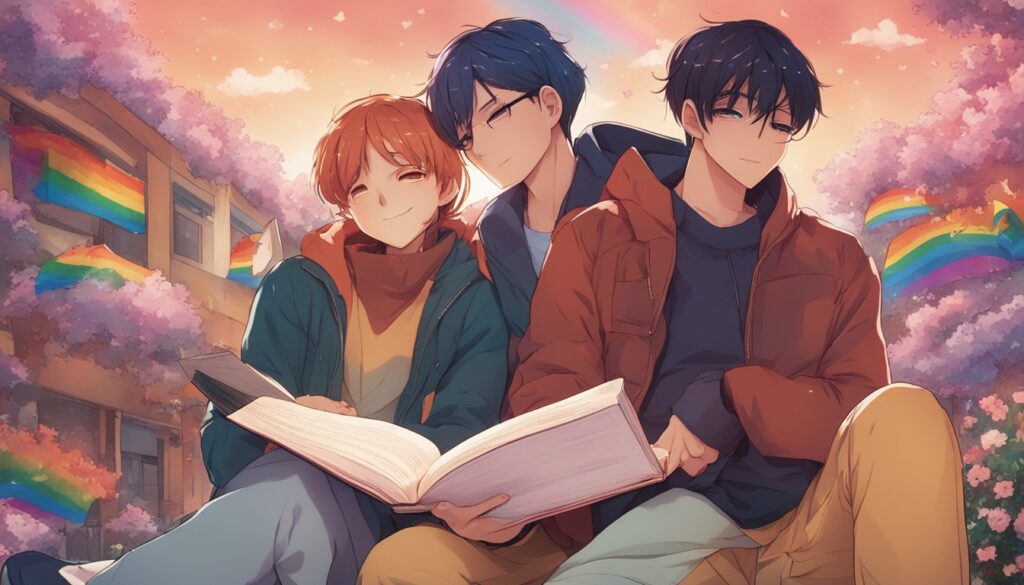
LGBTQ, Representation
This article takes a closer look at the varied world of LGBTQ+ characters in anime and manga. It spans through different genres and themes, showcasing the value of true and caring portrayals. These stories are about more than just breaking away from old views; they empower and affirm individuals.
In our world, seeing positive LGBTQ+ characters in media is crucial for kids and young folks. They should see themselves reflected positively. We’ve seen positive strides lately in shows like “Heartstopper” and “The Owl House”, as well as “Julian is a Mermaid”. But, we can do more to have varied and welcoming stories in all kinds of media.
There’s been progress over the last ten years in kids’ animated shows. We’ve seen the number of LGBTQ+ characters increase a lot. But, not all these stories are helpful. Some still fall into harmful clichés. Groups like Action for Children and leaders like Dr. Ranj are striving for better, more empowering stories.
Showing LGBTQ+ characters in a real and caring way is key. It can turn common views around, giving folks joy and a sense of belonging. Studies suggest this kind of media actually makes non-LGBTQ folks kinder and more supportive. This is how small screen time can make a big, positive change.
The world of anime and manga is expanding, demanding more diverse tales. These stories invite everyone, no matter their background, to listen and learn. By welcoming LGBTQ+ characters more, these arts can lead towards a brighter, more understanding future for us all.
Transgender and Non-Binary Representation
Anime and manga are leading the way in showing transgender and non-binary characters well. They look at the deep issues around gender identity and expression. This helps give valuable views and role models to the LGBTQ+ community.
Wandering Son (Hourou Musuko)
Wandering Son (Hourou Musuko) is a standout in transgender representation. It tells the story of Nitori and Takatsuki. They’re middle school students dealing with gender identity and the challenges that brings in life.
Boys Run the Riot
Boys Run the Riot focuses on Ryo, a transgender high school student, and his journey. It shows how Ryo finds himself through fashion, offering a unique view on non-binary representation.
| Statistic | Value |
|---|---|
| Percentage of non-LGBTQ Americans who personally know a transgender person | 28% |
| Increase in familiarity with LGBTQ people for non-LGBTQ adults exposed to LGBTQ community in media | 30% |
| Americans who like TV shows and movies that show transgender or nonbinary characters | 50% |
| Decrease in transgender characters on TV from the previous year | Down to 24 from 32 |
| Percentage of transgender characters out of 468 across scripted broadcast, cable, and streaming | 5% (24 characters) |
| Distribution of transgender characters by gender identity | 46% trans women, 21% trans men, 33% trans nonbinary |
| Racial distribution of transgender characters | 38% white, 21% black, 21% Latine, 13% multiracial, 4% API |
| Distribution of sexual orientation among trans characters | 38% queer with no other label, 30% straight, 21% bisexual+, 13% undetermined |
| Transgender characters on primetime scripted broadcast programming, scripted cable television, and original scripted streaming programming | 3, 2, and 19 respectively |
| Additional nonbinary characters who are not transgender | 16 |
The stats underline how important it is to keep adding transgender and non-binary representation in anime, manga, and media in general. While there has been some progress, we could still do better at showing all the diverse experiences within the LGBTQ+ community.
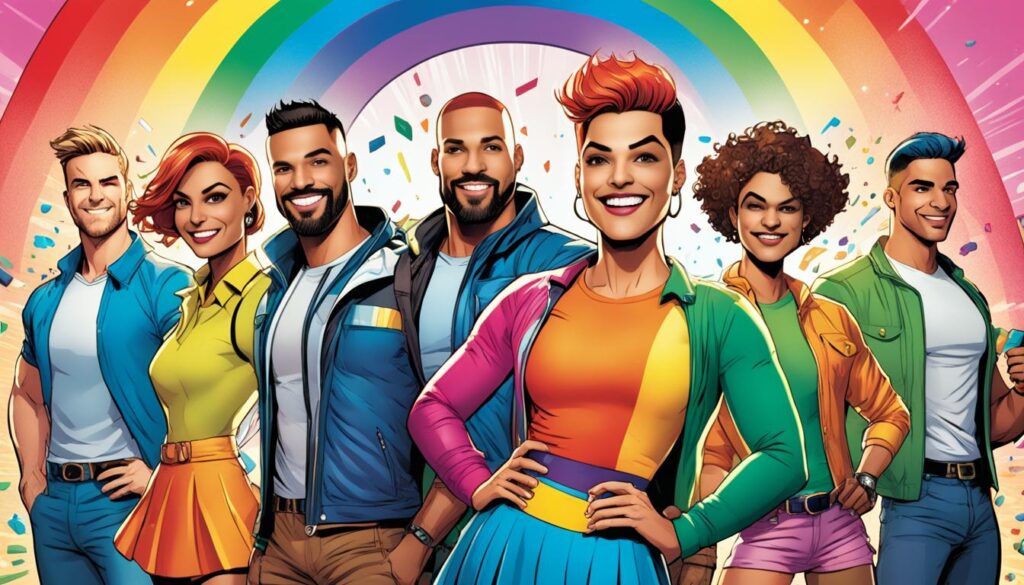
Autobiographical LGBTQ+ Manga
Among the vast world of manga, a unique subset shines brightly. Autobiographical LGBTQ+ manga, created by LGBTQ+ authors, invite readers into their world. They share their journeys with gender identity, sexuality, and self-discovery.
Two notable pieces in this category are
The Bride Was a Boy
and
My Lesbian Experience with Loneliness
. They offer an in-depth look at the lives of their creators. Beyond personal stories, these pieces truly reflect the LGBTQ+ experience.
These manga span from 2006 to 2022, showcasing varied artistic styles. They range from bright, colorful drawings to traditional black-and-white manga. Each story uncovers the authors’ personal quests. They also touch on broad topics like identity, family, and growth.
Readers will experience a rich collection of these personal tales. Each one reflects its author’s unique viewpoint. They shed light on struggles with LGBTQ+ identity, coming out, and self-love. Some stories also tackle race, disability, and acceptance in society.
At their heart, these manga are about deep personal exploration. They offer an authentic look at the LGBTQ+ journey. By sharing their stories, authors connect with readers on a profound level. This makes the manga powerful tools for understanding, guidance, and discovering oneself.
Fantasy and Sci-Fi Anime With LGBTQ+ Characters
The article shows how LGBTQ+ characters are in more than romance or slice-of-life anime. In fantasy and sci-fi shows, we meet LGBTQ+ individuals with interesting stories. These stories challenge old ideas and cover a lot of ground in different genres.
Carole & Tuesday is a great example. It has many LGBTQ+ characters in its storyline. Then there’s Heavenly Delusion. It plays with ideas about gender and shatters expectations.
There are other cool examples too. Like the fun show Nekopara with its cat girls. And Tomo-Chan Is A Girl! shows a character who likes both men and women. It makes us think about gender in new ways.
| Anime | LGBTQ+ Representation |
|---|---|
| Carole & Tuesday | Showcases a wide range of LGBTQ+ characters in a singular narrative. |
| Heavenly Delusion | Plays extensively with the concept of gender and breaks stereotypes. |
| Nekopara | Features lighthearted LGBTQ+ content with cat girls. |
| Tomo-Chan Is A Girl! | Portrays a character that attracts both men and women, questioning gender stereotypes. |
These shows take us to exciting places. Like in space or magical lands. They teach us about LGBTQ+ lives in ways that interest everyone. The characters and stories are really engaging.
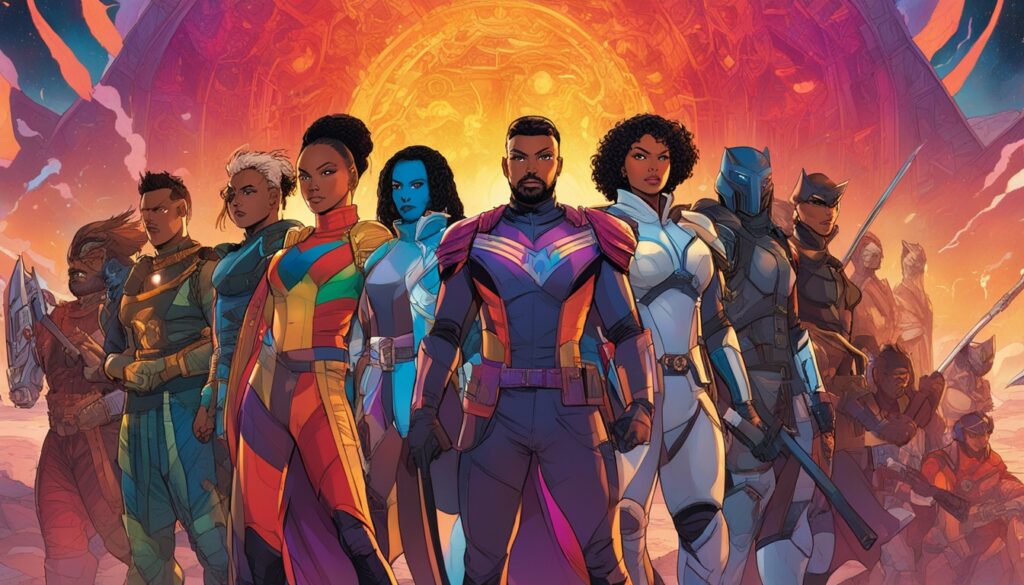
Anime Exploring Gender Identity and Expression
Anime like Paradise Kiss and Heavenly Delusion are known for their dive into gender themes. They question our usual ideas and roles, presenting a detailed view.
These shows focus on characters figuring out who they are. For many in the LGBTQ+ group, these stories offer something real and valuable to relate to.
Paradise Kiss
Paradise Kiss grabs you with its exploration of gender through its many characters. Yukari, a student, finds herself with a group known for their unique designs. Among them is Jōji, who blurs the lines between male and female.
As Yukari gets deeper into the fashion world, her own beliefs get turned upside down. Her journey is all about rediscovering who she truly is.
Heavenly Delusion
Heavenly Delusion is a sci-fi story with deep messages on gender. It tells of Maru, living in isolation, who must brave the dangerous outside. What Maru finds is a world unlike their own, filled with people who don’t fit the usual molds.
These encounters lead to a reevaluation of what gender really means. The show sheds light on the pressure society puts on us regarding our identities.
Both of these series are excellent examples of anime’s ability to highlight gender issues. They do more than entertain; they bring a fresh understanding to their audiences, especially those in the LGBTQ+ scene.
Classic LGBTQ+ Anime and Manga
This article highlights classic LGBTQ+ anime and manga series like Patalliro! and Princess Knight. They opened the door for LGBTQ+ representation in this art. Even after many years, these works keep their value in showing historical LGBTQ+ representation in anime and manga.
Patalliro!
Patalliro!, a manga by Mineo Maya since 1978, stands out. It shows a prince, Patalliro, who stands against gender norms. The manga’s story deep dives into gender and sexual orientation issues, which were not common back then.
Princess Knight
Princess Knight is from the 1950s, thanks to Osamu Tezuka. It tells about a princess who is both a boy and a girl. It’s among the first stories in anime and manga to explore gender identity and expectations.
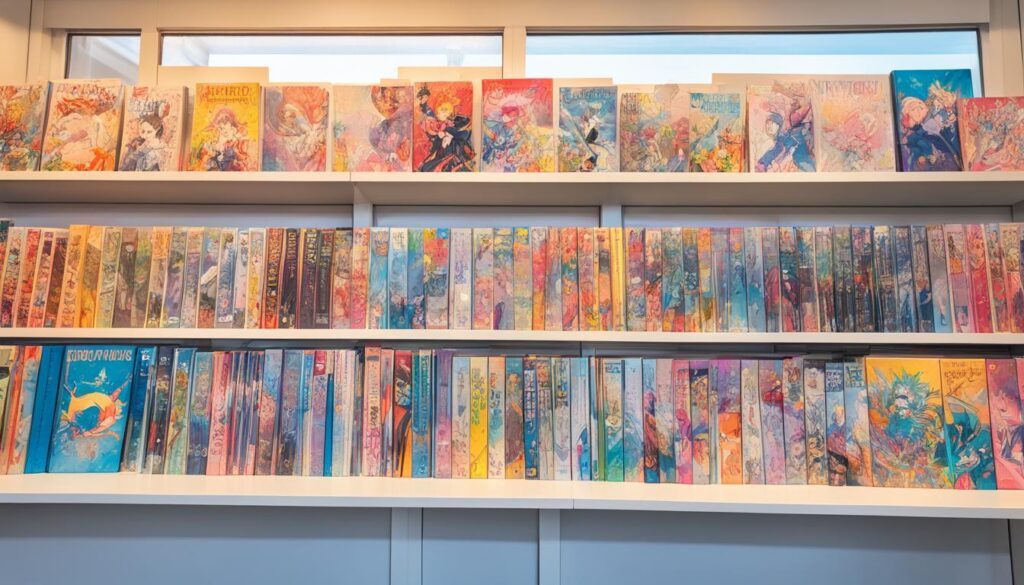
| Anime/Manga | Year | LGBTQ+ Representation |
|---|---|---|
| Patalliro! | 1978 | Features a young prince who defies traditional gender norms and embraces an androgynous persona. |
| Princess Knight | 1950s | Follows a young princess with both male and female characteristics, exploring themes of gender identity and expression. |
LGBTQ+ Representation in Music-Themed Anime
Anime series focused on music, like Carole & Tuesday, shine a light on LGBTQ+ stories. They show diverse LGBTQ+ characters and talk about important topics. These include identity, being accepted, and the impact of music. It’s a special way to connect with the LGBTQ+ community.
Carole & Tuesday is about two girls who start a music group. They face the tough music world and find themselves along the way. The show beautifully includes LGBTQ themes. It shows how music can change lives, no matter who you are.
Shows such as Carole & Tuesday use music to tell LGBTQ+ stories. They mix music with LGBTQ+ issues in a powerful way. Music becomes a tool for showing who you are and bringing folks together. This is meaningful for all fans of LGBTQ+.
Having LGBTQ+ themes in music anime is a big step for diverse stories. These shows not just entertain but also teach and inspire. They help us all learn more about LGBTQ+ life through music’s reach.
Ecchi and Fanservice LGBTQ+ Anime
The anime and manga world is changing. Now, there’s more LGBTQ+ representation than before. You can see it in lighter, fun shows. For example, the Nekopara series has cute cat characters that represent LGBTQ+ people.
These shows may not get very deep into LGBTQ+ lives like others do. But, they do make LGBTQ+ issues more fun and easier to watch. By mixing LGBTQ+ stories into popular genres, more people can see them and have fun.
Nekopara’s Cat Girls
The Nekopara series is all about colorful cat characters. It mixes fun adventures with bits of LGTBQ+ stuff. While it doesn’t go too deep into these, it still makes exploring these themes enjoyable.
Embracing Identity in Coming-of-Age Stories
Anime and manga, such as Blue Flag and Our Dreams at Dusk: Shimanami Tasogare, dive into LGBTQ+ themes. They explore identity, self-acceptance, and growing up. Their stories show the struggle and successes of accepting who you are. This is important for the LGBTQ+ community to see.
Blue Flag
Blue Flag is about high school students who face love, friendship, and finding themselves. It beautifully tells how LGBTQ+ characters realize who they are. They also discover acceptance around them, tackling issues many young people face today. The story shines a light on the unique paths LGBTQ+ people take while growing up.
Our Dreams at Dusk: Shimanami Tasogare
The plot revolves around a high schooler meeting a diverse LGBTQ+ community. Characters deal with fitting in and finding where they belong. The manga shows their internal battles and the support they find. It offers a deep look into finding one’s place in the world.
These stories are more than just entertainment. They give a voice to those often not heard. This helps promote empathy and a sense of community. By showing the power of accepting oneself, they can change how readers view their own stories.
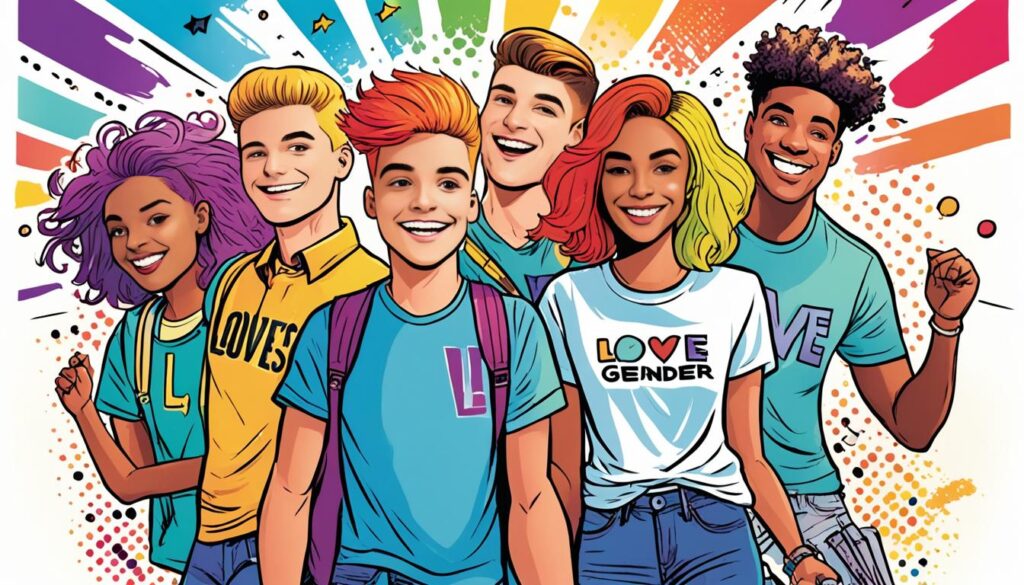
Conclusion
The way LGBTQ+ characters and themes are shown in anime and manga has gotten much better in recent times. This mirrors the trend we see in other types of media. We looked at many shows, from those about everyday life to fantasy and science fiction. This shows us how stories about LGBTQ+ people are changing in these popular forms of art.
The advancement of LGBTQ+ characters in mainstream TV and movies has made space for these changes in anime and manga. Scholars like Daniel Marshall and Stuart Hall say so. Series such as “The Fosters,” along with Roland Barthes’ ideas, have also shown us how important LGBTQ+ stories are in shaping what we think.
So, when we think about LGBTQ+ stories in anime and manga, it’s a big deal. These stories make a difference to LGBTQ+ people. They help tell diverse stories that many can connect with. By making more shows and comics with LGBTQ+ characters, we promote understanding and empowerment. This is key for fans and anyone who enjoys these forms of art.
FAQ
What are some popular anime series that celebrate LGBTQ+ representation?
Anime series like Yuri on Ice, Revolutionary Girl Utena, and Wandering Son have won hearts for their LGBTQ+ stories.
How do slice-of-life anime series portray LGBTQ+ relationships?
Slice-of-life titles like Bloom into You and Sasaki and Miyano are known for realistic LGBTQ+ themes. They focus on love, identity, and finding oneself.
What notable LGBTQ+ manga series have been produced?
The manga world boasts titles like Given and Whisper Me a Love Song. They highlight same-sex love and identity.
How do anime and manga series represent transgender and non-binary characters?
Works like Wandering Son and Boys Run the Riot are praised for their true-to-life trans and non-binary characters.
What are some examples of autobiographical LGBTQ+ manga?
Works like The Bride Was a Boy and My Lesbian Experience with Loneliness tell deep personal stories. They offer insight and comfort to those in similar journeys.
How does LGBTQ+ representation extend beyond the slice-of-life and romance genres in anime and manga?
LGBTQ+ stories are also part of fantasy and sci-fi genres. They introduce diverse characters and fresh narratives.
What are some examples of anime and manga series exploring gender identity and expression?
Shows like Paradise Kiss and Heavenly Delusion lead the way in challenging gender norms. They offer deep stories about self-discovery and expression.
What are some classic LGBTQ+ anime and manga series?
Classics such as Patalliro! and Princess Knight opened doors for LGBTQ+ tales. They remain important for understanding LGBTQ+ history in media.
How do music-themed anime series incorporate LGBTQ+ representation?
Shows like Carole & Tuesday use music to share LGBTQ+ stories. They focus on acceptance and the power of unity through music.
Are there LGBTQ+ characters in anime and manga genres like ecchi and fanservice?
Yes, even in ecchi and fanservice genres like Nekopara, LGBTQ+ characters appear. They add fun and lightness to the discussion of LGBTQ+ themes.
How do coming-of-age anime and manga series explore LGBTQ+ themes?
Works like Blue Flag and Our Dreams at Dusk show LGBTQ+ coming-of-age stories vividly. They depict the journey to self-acceptance with depth and sensitivity.
Source Links
- https://gamerant.com/lgbt-lgbtq-queer-anime/
- https://screenrant.com/best-lgbtq-manga-ranked/
- https://www.psychotherapy.org.uk/news/the-importance-of-lgbtq-representation/
- https://www.actionforchildren.org.uk/blog/representation-matters-are-lgbtq-young-people-seeing-themselves-represented-in-the-media/
- https://glaad.org/reference/entertainment/
- https://gaymingmag.com/2021/06/15-lgbtq-anime-celebrate-pride/
- https://collider.com/lgtbq-anime-series/
- https://www.grindr.com/blog/lgbtq-animes
- https://berkeleyfictionreview.org/2024/03/11/is-yuri-gay-on-queer-representation-in-japanese-media/
- https://www.nypl.org/blog/2019/06/17/beginners-guide-lgbtq-manga
- https://allofus.nih.gov/news-events/announcements/research-with-pride-lgbtqia-representation-all-of-us
- https://glaad.org/whereweareontv23/representation-of-transgender-characters/
- https://www.ncbi.nlm.nih.gov/pmc/articles/PMC6824534/
- https://www.glsen.org/blog/trans-representation-media
- https://slantedspines.com/2022/05/13/lgbtq-graphic-memoirs/
- https://www.cbr.com/great-sci-fi-fantasy-shows-lgbtq-main-characters/
- https://screenrant.com/best-sci-fi-fantasy-tv-shows-lgbtq-main-characters/
- https://theexonian.net/opinions/queer-representation-in-anime
- https://sabukaru.online/articles/a-deep-dive-into-queer-genders-and-gender-non-conformity-in-anime-and-manga
- https://digitalcommons.csumb.edu/cgi/viewcontent.cgi?article=2365&context=caps_thes_all
- https://en.wikipedia.org/wiki/LGBT_themes_in_anime_and_manga
- https://iitrqagaar.medium.com/why-anime-is-gay-queer-representation-in-anime-and-manga-11b6236d72a4
- https://www.nytimes.com/2021/06/13/opinion/trans-queer-ya-books-film-pride.html
- https://www.hbook.com/story/what-makes-a-good-ya-coming-out-novel
- https://popgoesthereader.com/recommendation-guide/110-young-adult-books-featuring-lgbtqia-representation/
- https://scholars.wlu.ca/cgi/viewcontent.cgi?article=1053&context=bridges_contemporary_connections
- https://www.ncbi.nlm.nih.gov/pmc/articles/PMC9027045/
- https://scholar.utc.edu/cgi/viewcontent.cgi?article=1133&context=honors-theses
